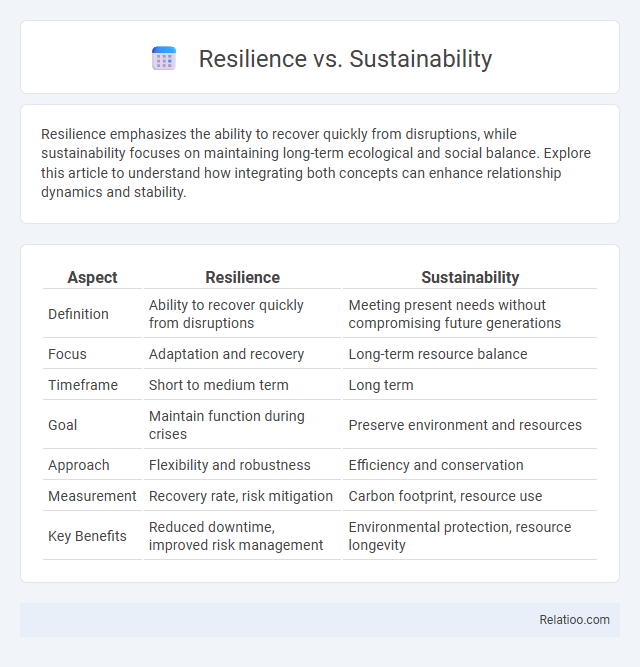Resilience emphasizes the ability to recover quickly from disruptions, while sustainability focuses on maintaining long-term ecological and social balance. Explore this article to understand how integrating both concepts can enhance relationship dynamics and stability.
Table of Comparison
| Aspect | Resilience | Sustainability |
|---|---|---|
| Definition | Ability to recover quickly from disruptions | Meeting present needs without compromising future generations |
| Focus | Adaptation and recovery | Long-term resource balance |
| Timeframe | Short to medium term | Long term |
| Goal | Maintain function during crises | Preserve environment and resources |
| Approach | Flexibility and robustness | Efficiency and conservation |
| Measurement | Recovery rate, risk mitigation | Carbon footprint, resource use |
| Key Benefits | Reduced downtime, improved risk management | Environmental protection, resource longevity |
Understanding Resilience and Sustainability
Resilience refers to the capacity of systems or communities to absorb shocks and recover quickly from disruptions, ensuring continuity and adaptability in the face of change. Sustainability focuses on meeting present needs without compromising the ability of future generations to meet their own, emphasizing long-term environmental, economic, and social health. Understanding resilience highlights the immediate adaptive responses to challenges, while sustainability emphasizes ongoing stewardship and balance for enduring well-being.
Key Differences Between Resilience and Sustainability
Resilience focuses on the ability to withstand, adapt, and recover quickly from disruptions or shocks, while sustainability emphasizes the long-term maintenance of environmental, social, and economic systems. Your organization's resilience ensures immediate response capabilities, whereas sustainability targets ongoing resource management and system health over time. Understanding these key differences allows you to balance short-term adaptability with enduring practices for future viability.
Historical Evolution of Both Concepts
The historical evolution of resilience and sustainability reflects distinct but overlapping paradigms in environmental and social sciences. Resilience originated in ecology during the 1970s, emphasizing a system's capacity to absorb disturbances and reorganize while maintaining function, whereas sustainability emerged from the 1987 Brundtland Report, focusing on meeting present needs without compromising future generations. Over time, resilience expanded beyond ecology into social-ecological systems, integrating adaptability and transformability, while sustainability incorporated economic, social, and environmental dimensions to promote long-term viability.
The Importance of Resilience in Modern Society
Resilience in modern society emphasizes the ability of communities and systems to adapt, recover, and thrive amid disruptions such as climate change, economic shocks, and technological failures. Unlike sustainability, which focuses on maintaining resources and minimizing environmental impact, resilience prioritizes flexibility and robustness to withstand unforeseen challenges. Building resilient infrastructure, social networks, and governance structures is essential for ensuring long-term stability and security in an increasingly complex and uncertain world.
Sustainability’s Role in Long-Term Progress
Sustainability plays a crucial role in long-term progress by ensuring resource efficiency, environmental protection, and social equity across generations. It integrates economic growth with ecological balance, supporting resilient systems that adapt to changing conditions while minimizing negative impacts. Sustainability frameworks guide policies and practices that promote durable development, fostering stability and continuous improvement over time.
Measuring Resilience vs Measuring Sustainability
Measuring resilience involves assessing a system's capacity to absorb shocks, adapt, and recover quickly from disruptions, often using metrics like recovery time, adaptability indices, and stress tolerance levels. Sustainability measurement focuses on long-term resource management, environmental impact, and social equity, typically quantified through carbon footprint, resource efficiency, and social well-being indicators. Your choice between measuring resilience or sustainability depends on whether the priority is immediate system robustness or enduring ecological and social balance.
Interconnections and Synergies Between Resilience and Sustainability
Resilience and sustainability are interconnected concepts that collectively enhance ecosystem stability and human well-being by promoting adaptability and long-term resource management. Synergies between resilience and sustainability emerge through practices that bolster ecological robustness while ensuring the continual availability of natural resources, such as adaptive agriculture and renewable energy systems. Integrating resilience strategies into sustainability frameworks improves the capacity to withstand environmental shocks and supports sustainable development goals by fostering ecological balance and social equity.
Practical Applications in Business and Communities
Resilience in business and communities emphasizes the ability to adapt and recover quickly from disruptions, ensuring continuity and minimizing losses. Sustainability focuses on long-term environmental, social, and economic health by promoting responsible resource use and equitable practices to maintain ecosystem balance. Your strategic approach should integrate resilience to manage immediate risks and sustainability to support enduring growth and community well-being.
Case Studies: Real-World Examples
Case studies reveal that resilience emphasizes adapting to disruptions, while sustainability focuses on long-term environmental and social balance, and both concepts overlap in enhancing system robustness. For example, the Netherlands' Delta Works project showcases resilience by protecting against floods, whereas Costa Rica's reforestation efforts highlight sustainability by promoting biodiversity and carbon sequestration. Your understanding benefits from examining these real-world examples to implement strategies that balance immediate response with long-term ecological health.
Building a Future: Integrating Resilience with Sustainability
Building a future requires integrating resilience and sustainability to create systems that not only endure shocks but also promote long-term environmental health. Resilience emphasizes the ability to recover from disruptions, while sustainability focuses on meeting present needs without compromising resources for future generations. Combining these concepts ensures communities and ecosystems remain robust, adaptable, and capable of thriving amid economic, social, and climate challenges.

Infographic: Resilience vs Sustainability
 relatioo.com
relatioo.com